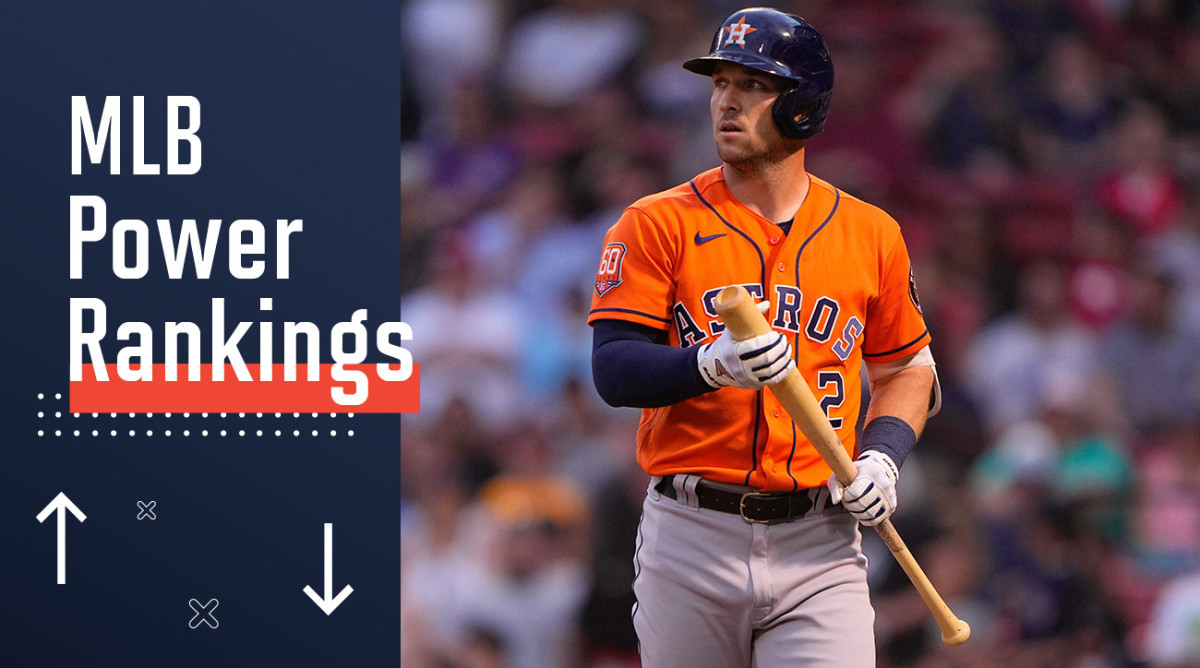Slugging percentage in baseball is a measure of a batter’s power. It calculates the total bases a player earns per at-bat.
Slugging percentage offers a deeper insight into a player’s ability than batting average, as it accounts for the quality of hits rather than just the quantity. This statistic values extra-base hits, rewarding players for doubles, triples, and home runs. By weighing heavier hits more significantly, slugging percentage provides a clearer view of a player’s offensive potency.
This metric is key for coaches, scouts, and fans aiming to gauge a hitter’s effectiveness and contribution to a team’s scoring potential. Understanding slugging percentage is essential for those who follow baseball statistics, as it captures a hitter’s power-hitting success over a season or career, distinguishing sluggers who drive in runs from those with fewer extra-base hits.

Credit: fastercapital.com
Slugging Percentage: The Power Indicator In Baseball
Slugging percentage (SLG) shines a spotlight on a player’s power hitting abilities. Unlike batting average, SLG considers not just hits, but the quality of those hits. It’s an essential tool for measuring a batter’s effectiveness at the plate.
The Essence Of Slugging Percentage
Calculated as total bases divided by at-bats, slugging percentage goes beyond singles. It looks at doubles, triples, and home runs. Higher totals mean more bases and more power.
| Hits | Bases |
|---|---|
| Single | 1 Base |
| Double | 2 Bases |
| Triple | 3 Bases |
| Home Run | 4 Bases |
To calculate: Add all bases from hits and divide by total at-bats. This percentage tells us runs a player earns with their hits.
Why Slugging Matters To Teams And Players
Teams use slugging percentage to find strong hitters. Players with high SLG often drive in runs and are key to winning games. They are valuable for their scoring potential.
- Scouting: Teams look for players with high SLG to boost offensive power.
- Contracts: Players with high slugging percentages often command larger salaries due to their run-scoring abilities.
- Lineup strategy: Managers arrange batting orders to maximize slugging players’ chances to hit with runners on base.
Therefore, slugging percentage holds a special place in evaluating performance and assembling impactful teams.
The Mathematical Formula Behind Slugging
Understanding the mathematical formula behind slugging gives us a deep dive into a player’s hitting capabilities. Slugging isn’t just about hitting the ball; it’s about hitting with power. So, how is this crucial baseball statistic calculated? Let’s unravel the magic numbers that can turn a regular batter into a statistical powerhouse.
Breaking Down The Components
Before delving into the calculation, let’s dissect what makes up slugging percentage. Slugging percentage accounts for all the bases a player earns with hits. It places a greater value on extra-base hits like doubles, triples, or home runs than on singles. Here’s the essence of slugging percentage:
- Singles: Worth one base
- Doubles: Worth two bases
- Tripples: Worth three bases
- Home runs: Worth four bases
We then compare the total bases to the number of at-bats to find a player’s slugging power.
Calculating Slugging: A Step-by-step Guide
The formula for slugging percentage (SLG) is the total number of bases divided by at-bats. Follow these steps to calculate it:
- Count the number of singles, doubles, triples, and home runs.
- Multiply singles by 1, doubles by 2, triples by 3, and home runs by 4.
- Add these numbers together to get total bases.
- Divide total bases by the total number of at-bats.
For a quick example, suppose a player has:
| Hit Type | Number of Hits | Bases Earned |
|---|---|---|
| Singles | 15 | 15 |
| Doubles | 10 | 20 |
| Tripples | 5 | 15 |
| Home runs | 4 | 16 |
Add up the bases: 15 (singles) + 20 (doubles) + 15 (triples) + 16 (home runs) = 66 total bases. If this player had 100 at-bats, their slugging percentage would be 0.660.
Note: A slugging percentage higher than 0.500 is considered excellent, indicating the player often makes extra-base hits.
Historical Emergence Of Slugging Percentage
Historical Emergence of Slugging Percentage delves into the roots of a statistic that has shaped baseball’s analytical framework. Baseball enthusiasts revere slugging percentage (SLG) for its ability to quantify a player’s power-hitting prowess. Understanding its historical significance offers insights into baseball’s evolving strategic approach.
Slugging’s Origins In Baseball Statistics
Slugging’s inception traces back to the early 20th century. Designed to provide a more nuanced picture of a batter’s performance, slugging percentage emerged as a valuable tool. It differs from batting average by not just accounting for hits, but the nature of those hits. This metric gained traction as teams realized the importance of extra-base hits in scoring runs.
Evolution Of Slugging In The Statistical Landscape
Slugging percentage underwent an evolution that mirrored baseball’s analytical sophistication. Initially overshadowed by simpler statistics, slugging grew in importance. The advent of sabermetrics in the latter half of the 20th century cemented slugging percentage as a fundamental gauge of a player’s offensive value. It now stands as a crucial component of the on-base plus slugging (OPS) statistic, a bedrock of player valuation.
Slugging Vs. Batting Average: A Comparative Analysis
In baseball, both slugging percentage and batting average measure a player’s performance. However, they highlight different aspects of hitting. Let’s break down how each statistic offers a unique perspective on a player’s offensive impact.
Defining Batting Average
Batting average is a traditional statistic. It tells us how often a player gets a hit. To calculate it, divide the number of hits by the number of at-bats. A higher batting average indicates a player hits more consistently.
Key Differences Between Batting Average And Slugging
Although both stats come from a player’s hits, they’re not the same. Batting average focuses on quantity, slugging percentage on quality.
- Batting average counts all hits equally.
- Slugging percentage weighs hits differently.
This table shows how slugging adds extra value to harder hits:
| Hit Type | Value in Batting Average | Value in Slugging Percentage |
|---|---|---|
| Single | 1 | 1 |
| Double | 1 | 2 |
| Triple | 1 | 3 |
| Home Run | 1 | 4 |
Slugging adds up these values and divides by at-bats. So, players hitting more doubles, triples, and home runs will have a higher slugging percentage.
The Impact Of Slugging On Player Evaluation
The Impact of Slugging on Player Evaluation extends beyond just a statistic on a player’s resume. It encapsulates the ability to hit the ball with power, often translating into game-changing plays and runs. When looking at slugging percentage (SLG), scouts and team management can discern who brings extra bases and runs to the table. This metric redefines how players prove their worth and secure their spot in the lineup.
Assessing Player Performance
Measuring a player’s effectiveness involves more than batting average. Slugging percentage is a powerful tool for assessment. It rewards players for extra-base hits. A single is good, but a double is better, and a home run is best. Players with high SLG are seen as threats at the plate.
- Single: Counts as one base
- Double: Counts as two bases
- Triple: Counts as three bases
- Home Run: Counts as four bases
By adding up total bases and dividing by at-bats, we get the SLG. It provides a clear picture of a player’s hitting power.
Slugging And Contract Negotiations
When it’s time for contract talks, SLG is a crucial figure. Players with high slugging percentages often command larger salaries. They are seen as game-changers, their ability to hit for power being a sought-after skill.
| Player Type | Slugging Percentage | Contract Implication |
|---|---|---|
| Power Hitter | High SLG | Potentially larger contract |
| Contact Hitter | Lower SLG | Less bargaining power |
Teams invest in players who bring in runs. Thus, slugger’s contracts often reflect their prowess. A healthy SLG can lead to lucrative deals, bonuses, and financial security for a player.
Misconceptions About Slugging Percentage
Many fans love baseball stats. One tricky stat is Slugging Percentage (SLG). People sometimes get it wrong. Let’s clear up some myths.
Debunking Common Myths
Myth 1: SLG tells us about speed. It does not. SLG shows power, not how fast a player runs.
Myth 2: Only home runs boost SLG. Wrong. Singles, doubles, and triples also increase it.
Myth 3: A high SLG means a good hitter. Not always. Other stats also matter for a hitter’s performance.
The Limitations Of Slugging As A Standalone Stat
SLG alone can mislead. It needs buddies like On-Base Percentage (OBP) to give a full picture. This duo makes On-Base Plus Slugging (OPS). OPS is better for judging hitters.
Think of SLG like a cake. Without all ingredients, it’s not good. SLG without OBP is like a cake without frosting. Good, but not complete.
Slugging Leaders: A Look At The Greats
In baseball, slugging percentage measures a player’s batting prowess. It’s how we gauge power. This stat favors extra-base hits. We’re about to dive into a realm where legends hold their ground and active players strive to etch their names amongst the giants. Who has left an indelible mark with their awe-inspiring slugging? Let’s venture into the history books and see who leads today.
Historical Slugging Percentage Leaders
Baseball’s pantheon showcases historical slugging leaders. These hitters’ legendary power often shifted games. Names like Babe Ruth and Ted Williams are etched in stone with their slugging exploits.
Let’s glance at some all-time greats:
- Babe Ruth: A titan with a slugging percentage that stands tall.
- Ted Williams: His on-base plus slugging still shimmers.
- Barry Bonds: A modern marvel whose numbers speak volumes.
Active Players Dominating The Slugging Charts
The baton has passed to active players rewriting the charts. Their swings pack a punch. Dynamic and thrilling, they keep fans on edge. Let’s spotlight those who rule the roost now.
Current kings of slugging include:
| Player Name | Team | Slugging Percentage |
|---|---|---|
| Fernando Tatis Jr. | San Diego Padres | .590 |
| Ronald Acuña Jr. | Atlanta Braves | .581 |
| Mike Trout | Los Angeles Angels | .582 |
Their mighty swings etch new tales of glory. Who will ascend next? The charts wait in anticipation.
Analyzing Slugging In Different Ballparks
Baseball fans often celebrate the crack of a bat. Yet, not all ballparks play the same tune when it comes to slugging percentage. This power-hitting metric can vary greatly depending on the stadium. Are you ready to dive in and see how different venues shape the game’s most explosive moments?
Park Factors Affecting Slugging Stats
Every ballpark has unique characteristics that influence a player’s slugging success. Let’s unpack these variables:
- Dimensions: The distance to the outfield fences can turn a pop-up into a homer or a blast into a long out.
- Altitude: Higher elevations can give the ball extra carry, helping it sail over the fence.
- Air Density: Humidity and temperature can suppress or enhance a ball’s trajectory.
- Wind Patterns: Wind can swiftly alter a game’s fate by knocking down potential home runs or pushing them out.
Each of these factors contributes to a park’s reputation as either a “hitter’s park” or a “pitcher’s park.”
Modifying Slugging Expectations By Venue
Slugging percentage speaks volumes about a player’s hitting ability. But smart fans know you need context. Compare stats from various parks for a true measure:
| Ballpark | Modifier |
|---|---|
| Coors Field | Boosts power numbers due to altitude |
| Oracle Park | Suppresses homers with deep right field |
| Fenway Park | Green Monster affects left-field slugging |
To level the playing field, look at adjusted slugging percentage or OPS+ that accounts for park factors. A deeper understanding of these metrics can paint a more accurate picture of a hitter’s prowess.
How Slugging Influences Batting Strategy
Understanding slugging percentage in baseball offers deep insight into a player’s hitting ability. It measures the power of a hitter, taking into account not just hits, but the value of each type of hit. A higher slugging percentage indicates a player who can hit more extra-base hits like doubles, triples, and home runs, which can lead to more runs. This statistic significantly shapes batting strategies and lineup decisions in baseball.
Offensive Tactics And Slugging
Teams prioritize slugging for its direct impact on scoring runs. Hitters with high slugging percentages are seen as critical pieces in the offensive puzzle. Teams develop strategies that leverage these hitters’ abilities to drive in runs and transform games. A focus on slugging encourages batters to:
- Optimize swing mechanics for both power and consistency.
- Select pitches wisely to maximize their chances of getting extra-base hits.
- Adjust their stance and timing to prioritize driving the ball with more force.
The Role Of Slugging In Lineup Construction
Coaches build lineups with slugging in mind. A team’s batting order is strategic, aiming to maximize scoring opportunities. The lineup often reflects:
| Order | Role | Typical Slugging Expectation |
|---|---|---|
| Top | Get on base | Lower |
| Middle | Drive in runs | Highest |
| Bottom | Turn the lineup over | Varies |
Players with strong slugging percentages often hit in the middle of the order. This ensures they get to bat with teammates on base, increasing the chances of driving in multiple runs with a single hit. This strategic placement in the lineup underscores the value of slugging in a team’s offensive strategy.
Slugging In The Sabermetrics Era
Baseball aficionados know that slugging percentage is a vital statistic. It offers a robust snapshot of a player’s power-hitting abilities. As the Sabermetrics era unfolds, slugging becomes more nuanced. Advanced metrics grant fans a deeper insight into a hitter’s overall impact.
The Integration Of Slugging In Advanced Metrics
Slugging percentage, once a standalone stat, merges seamlessly into Sabermetrics. It now intertwines with other advanced metrics to provide a fuller picture.
Table showing the integration of slugging into other metrics| Metric | Description | Role of Slugging |
|---|---|---|
| OPS | On-base Plus Slugging | Direct component, measures total effectiveness |
| ISO | Isolated Power | Derived from slugging, assesses raw power |
| WAR | Wins Above Replacement | Contributing factor, slugging impacts overall value |
Incorporating slugging with on-base percentage birthed OPS. ISO digs deeper, isolating extra bases hit. WAR evaluates a player’s worth against a replacement. Slugging is key to these metrics.
How Sabermetrics Enhances Understanding Of Slugging
Sabermetrics turns traditional stats into dynamic tools for deeper evaluation. It sheds light on contextual performance.
- Contextual slugging: Metrics like wRC+ adjust slugging based on ballpark factors.
- Comparative analysis: Sabermetrics enables era-to-era comparison, ensuring fair assessment.
- Predictive focus: Slugging-linked metrics forecast future performance, aiding in strategic decisions.
These advanced methods ensure that slugging percentage is not seen in isolation. A player’s slugging capacity is now understood as part of a larger ecosystem. Every hit, every base, and every game situation gains clarity through the lens of Sabermetrics.
Improving Slugging: A Guide For Players
In baseball, the slugging percentage measures a player’s batting power. Stronger hits often lead to better slugging. Here’s a player’s guide to improving slugging, from training tips to a solid mental approach.
Training Techniques For Power Hitting
When seeking more force at the plate, consider these techniques:
- Weight Training: Focus on building core and leg strength.
- Bat Speed Drills: Develop quick wrists and hands for swifter swings.
- Tee Work: Practice hitting balls from a tee to enhance accuracy.
- Video Analysis: Review your swings to identify and fix weak spots.
Consistent practice using these methods can result in noticeable gains in your slugging percentage.
Mental Approach To Increasing Slugging
Mental readiness is key for successful slugging. Employ the following strategies:
- Visualize Success: Imagine hitting strong home runs during practice.
- Stay Positive: Keep a positive mindset, even after misses. Confidence fuels performance.
- Plate Discipline: Learn to recognize pitches and when to swing for the best impact.
Combining mental preparedness with physical training leads to a formidable presence at the plate.
Future Of Slugging Percentage In Baseball Analytics
Slugging percentage (SLG) is a measure of a batter’s power. It has been a staple in baseball analytics for years. As we move forward, SLG’s role in the evolving landscape of baseball statistics may change. Future analytics will likely enhance how we understand a player’s power at the plate.
Predicting Trends And Innovations
Innovations in technology shape baseball’s future. High-speed cameras and advanced tracking systems offer a deeper dive into a player’s hitting mechanics. These could impact SLG’s relevance.
- Statcast: A new era of tracking capable of dissecting every play.
- Machine Learning: Algorithms predict future performance, possibly refining SLG.
The Potential For New Power Metrics
New metrics are on the horizon. They might provide a clearer picture of a player’s power.
| Current Metric | New Metrics | Insights Offered |
|---|---|---|
| SLG | Barrel Rate, Exit Velocity | Quality of contact, Potential distance |
| Home Runs (HR) | Launch Angle, Sweet Spot% | Trajectory analysis, Swing efficiency |
Exit velocity and launch angle are gaining attention. Combined, they might outshine traditional SLG in representing power.
Beyond The Diamond: Slugging’s Role In Fantasy Sports
Understanding slugging percentage in baseball opens a world of strategy in fantasy sports. This key statistic measures a player’s power. It tells fantasy league enthusiasts how often a player hits singles, doubles, triples, or home runs. In fantasy sports, a robust slugging percentage can mean the difference between winning and losing.
Strategizing For Fantasy Baseball
Mastering fantasy baseball requires a blend of skill and knowledge. At its core, strategy is about picking players who will perform well on the field. Here are some tips for crafting a winning team:
- Analyze player statistics to forecast future performance.
- Balance your roster with a mix of consistent hitters and power players.
- Keep an eye on player injuries and trade opportunities.
- Track real-world matchups to predict which players will thrive.
Slugging: A Key Stat In Player Selection
Slugging percentage isn’t just a number; it’s a forecast of potential scoring. Here’s why slugging is critical in player selection for fantasy sports:
- High slugging players often contribute more points.
- They can turn the game with a single powerful hit.
- Sluggers are valuable in categories like RBIs and total bases.
- Selecting sluggers can bolster your team’s offensive prowess.

Credit: www.si.com

Credit: www.mlb.com
Frequently Asked Questions For What Is Slugging Percentage In Baseball?
What Does Slugging Percentage Measure?
Slugging percentage quantifies a player’s total bases per at-bat, highlighting power hitting.
How Is Slugging Percentage Calculated?
Divide a player’s total bases by their number of at-bats to calculate slugging percentage.
Why Is Slugging Percentage Important?
It gauges a batter’s effectiveness at generating extra-base hits, crucial for run scoring.
Conclusion
Understanding slugging percentage offers deeper insight into a player’s hitting ability. This metric is pivotal for coaches, players, and fans alike. By grasping slugging percentages, one can truly appreciate the power and efficiency of hitters in baseball. Elevate your game analysis by keeping an eye on this key statistic.


